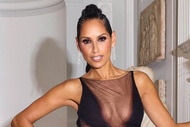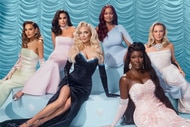
Create a free profile to get unlimited access to exclusive videos, sweepstakes, and more!
Will Men's and Women's Fashion Eventually Morph Into One?
Even Zara's putting out "Ungendered" collections.

Is the future of the runway co-ed? Practically every few weeks, another fashion house announces that it will show its men’s and women’s collections together (Coach, Kenzo, and Gucci included).
Meanwhile, designers like Rad Hourani are dreaming up collections that are completely unisex, with pieces like coats and skirts that look great on anyone. Back in 2015, London department store Selfridges debuted a gender-neutral section of its department store and even Zara unveiled an “ungendered” collection last year to mixed reviews (this season's collection weirdly includes an Alf T-shirt).
Throw in Jaden Smith’s 2016 appearance in a skirt in a Louis Vuitton ad and menswear label Palomo Spain’s off-the-shoulder velour tracksuits that women are snapping up, and it’s clear that gender boundaries in fashion these days are anything but clear.
So maybe the bigger question is: will men’s and women’s clothing one day morph into one?
Retail experts have an interesting theory about fashion’s gender-blurring movement. "It's a consumer-born trend,” said Marshal Cohen, chief industry analyst at NPD, a market research company that put out a report in 2015 about the rise of gender-neutral fashion. Cohen points toward everyday examples, like the popularity of Adidas Superstars or Chuck Taylors with men and women.
TrendWatching's senior trend analyst Vicki Loomes has a similar thought, that fashion designers are reacting to the world around them. “Fashion was traditionally decided by a few houses at the top who set the styles, and then it trickled down,” she says. “It's not just that fashion is now taking the bottom up approach to the actual clothes they're designing, I think they're also taking the bottom up approach to the kind of people they're designing for. They're looking at how people are really living and how people are putting their clothes together and are choosing to create their own wardrobes and they are then reacting to that as well."
The way shoppers discover fashion now has totally changed too, Vicki points out: you can use Instagram to find out what cool teens are wearing in Tokyo and buy their exact clothes, or contribute to a Kickstarter for a new designer who is dreaming up the exact thing your shopping list is missing.
“The borders between cultures as well have blurred. All of them are kind of combining to make gendered fashion feel very archaic and something that isn't really that relevant today,” Vicki says. “I think all of those old stereotypes of what you were meant to be if you were a woman, or what you were meant to be if you were a man, have also kind of eroded in the same process. You can choose how you want to be as a person, not something that's totally defined by your gender.”
Louis Vuitton designer Nicolas Ghesquière said something similar when Jaden Smith’s LV campaign came out, telling the New York Times that Jaden “represents a generation that has assimilated the codes of true freedom, one that is free of manifestoes and questions about gender. Wearing a skirt comes as naturally to him as it would to a woman who, long ago, granted herself permission to wear a man’s trench or a tuxedo.”
This might be a case where the mall needs to catch up to shoppers: since NPD’s report came out in 2015, Marshal hasn’t seen much of a change in mass market retailers' approach to gender neutral clothing. “From a fashion standpoint, runways and brands and designers have been talking about it but you're seeing very little adaptation,” he says. The one aisle where this is changing is the toy section, with stores like Target removing gender-based signs.
Will gender lines in clothing ever completely blur in the future? “There probably will always be clothes that are more likely to be worn by men or clothes that are more likely to be worn by women, but I think the actual sort of segmentation of men's fashion and women's fashion — they will continue to segue into each other,” Vicki says.
Technology is what will eventually push unisex clothing further, according to Marshal. “I think over the time when we really start to change the dynamic of what we wear and what the product is made of, you will see stretch fabrics that don't have to be contoured to the male and female body,” he says. “They'll be contoured to the size and you'll stretch it to the width and shape that you need.”
One more question: you always read headlines in women’s magazines like “An Expert Guide to Borrowing From the Boys,” but will your average guy ever try out womenswear?
“Creative people will find ways to take female product and turn it into their own. Again, that's not the retailer doing it, it's creative individuals,” Marshal says. “I think you'll see more and more of that over time, and one or two designers will take some of the female style and influence and put it into the flair for the guys. We're starting to see that accepted and eventually we'll be at a place where guys won't be so intimidated to wear female-influenced products. Don't be surprised if that's where it starts.”


























